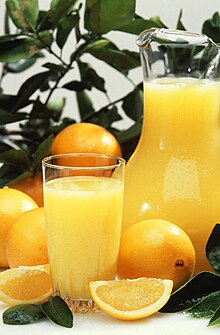| Revision as of 15:22, 8 April 2005 view source12.177.48.103 (talk)No edit summary← Previous edit | Revision as of 15:24, 8 April 2005 view source Ahoerstemeier (talk | contribs)110,683 editsm Reverted edits by 12.177.48.103 to last version by Mb1000Next edit → | ||
| Line 3: | Line 3: | ||
| ] | ] | ||
| '''Orange juice''' is the liquid obtained by squeezing or pressing the interior of an ]. It is enjoyed as a ] in many parts of the world. It is sometimes referred to by the abbreviation "'''O.J. |
'''Orange juice''' is the liquid obtained by squeezing or pressing the interior of an ]. It is enjoyed as a ] in many parts of the world. It is sometimes referred to by the abbreviation "'''O.J.'''" | ||
| The largest ]er of orange juice is ], followed by ]. Orange juice is commonly exported in dried form and infused in the destination country. Juice which is shipped in |
The largest ]er of orange juice is ], followed by ]. Orange juice is commonly exported in dried form and infused in the destination country. Juice which is shipped in liquid form is traded as "direct juice" between producers. It is sold to consumers (in the USA) with the label 'Not from ]'. | ||
| Fresh orange juice generally has a fruity and |
Fresh orange juice generally has a fruity and pleasantly ]ic taste. It contains a high amount of ] (]). Some manufacturers add ] or ascorbic acid to their products, in addition to other nutrients such as ] and ]. | ||
| Frozen Concentrated Orange Juice (FCOJ) is a commodity product traded on the major commodity exchanges, including the ] and the ]. | Frozen Concentrated Orange Juice (FCOJ) is a commodity product traded on the major commodity exchanges, including the ] and the ]. | ||
| When water is added to freshly-unfrozen FCOJ, it is '''reconstituted'''. Almost all orange juice sold in the United States is reconstituted juice, since there is a huge difference in the volume of FCOJ and unprocessed juice and this makes a difference in the price the consumer is charged. | When water is added to freshly-unfrozen FCOJ, it is '''reconstituted'''. Almost all orange juice sold in the United States is reconstituted juice, since there is a huge difference in the volume of FCOJ and unprocessed juice and this makes a difference in the price the consumer is charged. | ||
Revision as of 15:24, 8 April 2005
This article is about the fruit juice; For alternate uses, see Orange juice (disambiguation).

Orange juice is the liquid obtained by squeezing or pressing the interior of an orange. It is enjoyed as a beverage in many parts of the world. It is sometimes referred to by the abbreviation "O.J."
The largest exporter of orange juice is Brazil, followed by Florida. Orange juice is commonly exported in dried form and infused in the destination country. Juice which is shipped in liquid form is traded as "direct juice" between producers. It is sold to consumers (in the USA) with the label 'Not from concentrate'.
Fresh orange juice generally has a fruity and pleasantly acidic taste. It contains a high amount of vitamin C (ascorbic acid). Some manufacturers add citric acid or ascorbic acid to their products, in addition to other nutrients such as Calcium and Vitamin D.
Frozen Concentrated Orange Juice (FCOJ) is a commodity product traded on the major commodity exchanges, including the Chicago Mercantile Exchange and the New York Mercantile Exchange.
When water is added to freshly-unfrozen FCOJ, it is reconstituted. Almost all orange juice sold in the United States is reconstituted juice, since there is a huge difference in the volume of FCOJ and unprocessed juice and this makes a difference in the price the consumer is charged.
There is some disagreement about the quality of fresh-squeezed juice versus juice that has been processed into FCOJ and reconstituted. However, while it might seem that FCOJ would reduce the 'freshness' of the juice, the time required for the juice to be squeezed, bottled/packaged, and delivered to the consumer might reduce the flavor just as much as the concentration / freezing process.
External Links
How orange juice is made and the different types of it
Category: